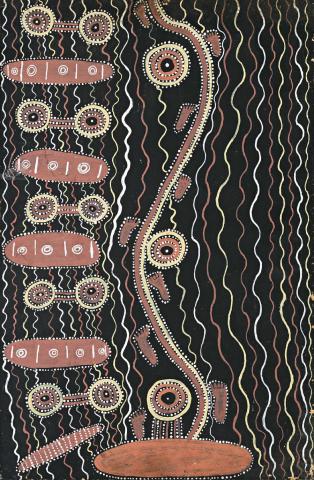OLD MAN'S MEDICINE STORY, 1971
LONG JACK PHILLIPUS TJAKAMARRA
synthetic polymer powder paint on composition board
72.0 x 46.0 cm
signed verso: Jack
inscribed verso: Stuart Art Centre consignment no. 5075
Executed at Papunya, December 1971
Consignment 5, painting 75, Stuart Art Centre, Alice Springs
Private collection, Canberra
Bardon, G. and Bardon, J., Papunya, A Place Made After the Story: The Beginnings of the Western Desert Painting Movement, The Miegunyah Press, Melbourne, 2004, p. 293 for an illustration of the original field notes and drawing by Geoffrey Bardon.
The annotated field notes depict the big penis going walkabout looking for a wife being followed by the testes, the feet of the man chasing his genitals are shown and patterns of the sand.
Long Jack Phillipus Tjakamarra was born at Kalipinypa, a major Water Dreaming place, north-east of Walungurru, in his mother's country. When Long Jack was a teenager, he and his family group walked into Haasts Bluff, where he worked as a timber cutter and stockman. From 1962 along with his family he moved to Papunya where he gained employment as a grounds man and was a member of the community council. A deeply religious man, he was both a missionary and pastor for the Western Desert People as well as being learned in traditional culture.
In 1971, Tjakamarra, along with Billy Stockman, painted small murals around the Papunya School preceding the major Honey Ant murals collaboration by Papunya artists. These early works were highly iconographic often made up of simple geometric shapes, such as roundels, ovoid forms and crescent shapes. He painted water, Wallaby, Kingfisher, Dingo, Possum and Emu Dreamings. A number of his early works on board depict decorated ceremonial participants and ritual objects demonstrating visually the strength of their culture and law. Old Man's Medicine Story is one such painting. This painting clearly relates to the Old Man Dreaming also depicted by Uta Uta Tjangala and Charlie Tararu Tjungurrayi. The first medicine paintings were recorded in Pat Hogan's notes with regard to paintings sent as part of consignment 2 to the Stuart Art Centre in 1971. A number of versions of this story were executed by Long Jack Phillipus Tjakamarra and found in consignments 2 and 5 in 1971 and later in consignment 12 in 1972.
Anthropologist Fred Myers who worked extensively with Pintupi artists has recorded this myth and notes that the Old Man was powerful and dangerous, one'who carried dangerous sorcery objects in his headdress'.1 After having illicit sexual relations with his classificatory Mother in law which was forbidden, the Old Man moved on but his penis swelled up and he suffered painful torment. The pain increased as he moved west until his testicles fell off or went walk about.
Of the 40 founding painters, known as the painting men, of the Western Desert School, only three remain. Long Jack Phillipus Tjakamarra began painting for Papunya Tula Artists at its inception in 1973 and went on to become the organization's Chairman in the early 1990s.
1. Myers, F.R., Painting Culture: The Making of an Aboriginal High Art, Duke University Press, Durham and London 2002, p 42 and pp. 39-43 for a detailed analysis of the mythological Old Man Story.
